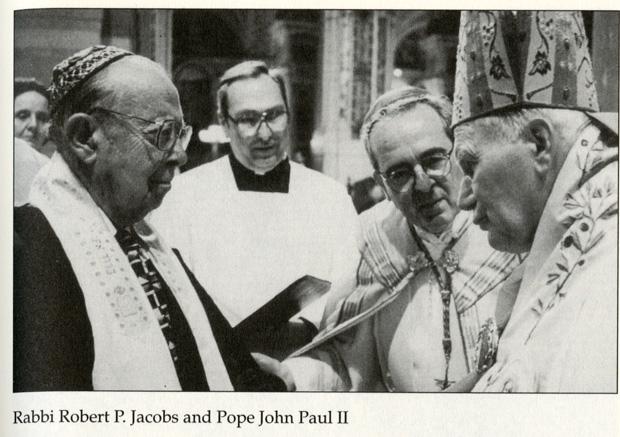St. Louis rabbi was front and center during historic papal visit
Published March 20, 2013
As worldwide headlines focus on the election and installation of Cardinal Jorge Mario Bergoglio of Argentina as Pope Francis I, Cohnipedia flashes back to January 1999, when Pope John Paul II made a historic visit to St. Louis, the first such visit by a reigning pope. On that visit, local Jewish history was also made when the late Rabbi Robert P. Jacobs, then 90 years of age and the senior rabbi of Greater St. Louis, took part in an interfaith service at the Cathedral Basilica in St. Louis.
Beloved by his colleagues and respected by Jews from all streams of Judaism and faith groups in St. Louis, Jacobs was given the honor of reciting a passage from the Hebrew Bible (called “the Old Testament” by Christians) at that historic service. He chose a passage from the Book of Isaiah, which he had committed to memory while a student at the Hebrew Union College-Hebrew Institute of Religion.
ADVERTISEMENT
Pope John Paul II had done much to improve Catholic-Jewish relations during his reign, including a visit to the Great Synagogue in Rome. There, he insisted that he and the Chief Rabbi of Rome sit in identical chairs to indicate his respect for Judaism as a sister faith in the “Tent of Abraham.”
The Polish-born pope, who grew up as Karol Wojtyla, had close friends in the Jewish community of Cracow since childhood. He was opposed first to the tyranny of the Nazis who invaded his country and then of the Soviet-backed Communists who ruled Poland in the postwar years. As pope he visited the site of Auschwitz in his native Poland where more than 1 million Jews were murdered by the Nazis. He knelt before a memorial monument and pronounced anti-Semitism a “grave sin.” He also visited the State of Israel, with which he established full diplomatic relations, and placed a prayer for peace at the Western Wall in Jerusalem.
Rabbi Jacobs, a native of Syracuse, N.Y., served as director of St. Louis Hillel at Washington University and then as executive vice president of the St. Louis Rabbinical Association for three decades. He received his rabbinic ordination from HUC-JIR in 1933, the year that Adolf Hitler came to power in Germany.
The rabbi was well aware of the horrors of the Holocaust and of the long history of hostility between the Catholic Church and world Jewry—including the Crusades, the Spanish and Portuguese Inquisitions, forced conversions and the teachings that blamed Jews for the Crucifixion of Jesus of Nazareth. The Second Vatican Council did much to ameliorate this troubled history, but the courageous work of Pope John Paul II, which was continued by his successor, Pope Emeritus Benedict XVI, truly made history.
ADVERTISEMENT
Pope John Paul II, 78 years of age when he visited St. Louis, was weary after the grueling schedule of travel and appearances he made during his visit. Rabbi Emeritus Jeffrey Stiffman of Congregation Shaare Emeth noted at the time that the pope looked very tired and his head was down before Rabbi Jacobs spoke.
But the moment that Jacobs began to read the selection from Isaiah in his distinctive, bell-like voice, the pope sat up and smiled broadly. The words of Isaiah, a Prophet revered by both Jews and Christians, filled the large Cathedral Basilica and reverberated throughout the room.
After the service, as guests were invited to the pulpit to greet the pope, Jacobs said to Pope John Paul II, “Thank you for changing history by reaching out so positively to the Jews of the world.” The pope replied, “Thank you, Rabbi, for taking note of what I was trying to accomplish.”
And so, as the world gets to know the new Pope Francis I, who also has a splendid record of positive relations with the Jews of his native Argentina, let us look back with gratitude on that day on Jan. 27, 1999, when the Senior Rabbi of St. Louis met the Supreme Pontiff of the Catholic Church and Bishop of Rome. May their records of interfaith harmony and cooperation continue to illuminate our path in the years ahead.
















